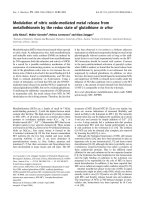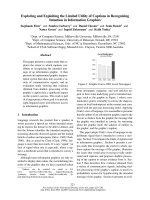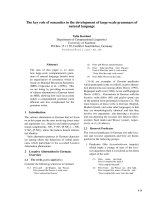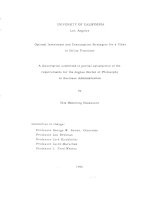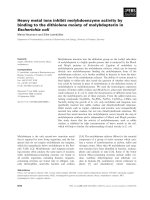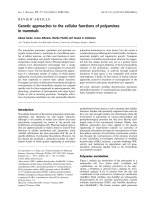The promised land for men the rising popularity of hosts in contemporary japanese society
Bạn đang xem bản rút gọn của tài liệu. Xem và tải ngay bản đầy đủ của tài liệu tại đây (2.48 MB, 455 trang )
A PROMISED LAND FOR MEN:
THE RISING POPULARITY OF HOSTS IN
CONTEMPORARY JAPANESE SOCIETY
REIKO YAMAGISHI
NATIONAL UNIVERSITY OF SINGAPORE
2009
A PROMISED LAND FOR MEN:
THE RISING POPULARITY OF HOSTS IN
CONTEMPORARY JAPANESE SOCIETY
REIKO YAMAGISHI
(M.A. Women’s Studies, The University of Alabama)
A THESIS SUBMITTED
FOR THE DEGREE OF DOCTOR OF PHILOSOPHY
DEPARTMENT OF SOCIOLOGY
NATIONAL UNIVERSITY OF SINGAPORE
2009
i
ACKNOWLEDGEMENTS
One of my professors once told me, “Writing a dissertation is one of the most stressful
events of life.” Perhaps. But I did not find this to be true in my case. My dissertation, on
the other hand, was my lifesaver.
On April 12
th
2006, six months after I had returned to NUS from fieldwork in Japan, I
was rear-ended by a car which had not stopped at the stop-sign at the road junction, while
cycling to an appointment. The accident left me physical, financial and emotional drained.
On top of having to write my dissertation, I had to look for doctors and lawyers who
could help me. Being a foreigner, and student, did not help. My unfamiliarity with legal
and medical matters caused me to be misled and taken advantage of. The ongoing search
for medical and legal support, attending physical therapy, and consulting with lawyers
all-in-all was extremely time-consuming, difficult, and emotionally taxing, taking away
so much valuable time from my writing. And was it not Shakespeare who said “When
sorrows come, they come not single spies, but in battalions.”?
My life during this period
proved him right. Since the accident, like the script of a bad soap-opera, more and more
unfortunate incidents unfolded. I felt I was in a dark tunnel that had no exit.
It was however the writing of my dissertation that saved me from collapse. I knew that
what I had done was something new and interesting. I believed that my work would
contribute to studies in this field of research. But most importantly, I was totally in love
with my research. Yet, the completion of this dissertation would not have been possible
without the kind assistance of many people helping me over the last two years. I would
like to take the opportunity here then to thank all these people for their support.
I had the best advisers. Prof. Maribeth Erb and Prof. Hing Ai Yun did everything they
could possibly do to support me in getting this dissertation done. They constantly
challenged me intellectually, while at the same time they were mentors who were so
encouraging, providing emotional support. They believed in me and that kept me going.
At one point, it became critical that I obtained some financial support in order to continue
with the Ph.D. program. It was Prof. Tong Chee Kiong and Prof. Pauline Straughan who
lent their hand in this area. Without their kindness, it would have been impossible for me
to continue.
Prof. Thang Leng Leng, Prof. Chua Beng Huat, and Dr. Eric Thompson: thank you very
much for your great advice and continuous encouragement. Saroja and Chaar, I truly
appreciate your sincere concern and unconditional offer of help to alleviate my pain. And
Roland at the Fujitsu repair center, your technical support was very essential for me.
Finding doctors who understand patients’ physical and emotional pain and who treat
patients as individual human-beings was amazingly hard. A visit to the doctor would
often be stressful because of the negative and unsupportive attitude. But I have also met
caring doctors and nurses over the last two years. Dr. Lee and nurse Joyce at the
acupuncture clinic at NUS, chiropractor Nancy, masseurs Suzanna and Lay Hoon, and
ii
surgeon Siegal Bernie—you were all so inspiring and your friendship has meant a lot to
me.
Life without laughter is not worth living. Especially during hardship. My friends and flat-
mates —Noorman, Grace, Meisen, Bambi, Charan, Naoko, Maki, Geklin, Momoko, Rob,
Nhidi, and Taberez—were always there for me, helped me whenever I was in need, and
most importantly, made me laugh. And I would like to especially thank Kelvin Low and
his family—his parents Mr. and Mrs. Low and his brother Les—for having taken great
care of me and for treating me like family.
This dissertation would not have been completed without the tremendous help and
dedication of Mr. Eric Goh. He is an excellent editor who is positive and encouraging.
And he has tried his best to support me, unconditionally.
Lastly, Ai Jin, this dissertation is dedicated to you. One day she said,
There is a man who has nothing and when he finds ten cents on the street,
he picks it up and makes a call to his friend for help. Reiko, we still have
steps to take, so we have to take them. And when we run out of steps, we
think of how we can push it further until there is really nothing more to
take.
What I have learnt in the past two years is that “life is hard and unfair.” My journey has
been rough and rocky. But there was always Ai Jin, who tried her best to make my path as
smooth as possible, and had put her head together with mine to find a step. My journey
continues, and the tunnel called “life” seems to be too long and too dark sometimes. But I
know I will make it. Whenever I think of you, Ai Jin, I can picture you crying and
smiling with the joy of seeing me happy again. I will make this happen. Yes, we will be
smiling together—soon.
iii
TABLE OF CONTENTS
Page
ACKNOWLEDGEMENTS . . . . . . . .i
TABLE OF CONTENTS . . . . . . . .iii
SUMMARY . . . . . . . . . .vii
PART I: SETTING THE SCENE
I. INTRODUCTION . . . . . . . .1
Prelude: A Taste of the Hosts’ Wonderland . . . .1
The Research Focus . . . . . . .9
Rationale of Study . . . . . . .14
Research Limitation, Objectives and Questions. . . .18
Issues in the Representation of Hosts and
Operational Terminologies. . . . .20
a) Japanese Terminologies . . . . . .20
b) Hosts as Sex Workers? . . . . . .20
c) Junior Hosts vs. Senior Hosts . . . . .23
d) The Modern Host Club Industry vs. the Host Club Industry,
and the Modern Host Club Industry as “Industry” . .24
e) Profiles of Hosts and the Media Sources . . . .25
Thesis Structure . . . . . . .26
II. METHODOLOGICAL AND ETHICAL ISSUES . . .29
Constructive Interpretivist Approach . . . . .29
Outlining the Fieldwork . . . . . .30
a) The Research Site . . . . . . .30
b) Research Methods and the Research Participants . . .36
c) Participant Observation . . . . . .39
d) Gaining Access . . . . . . .44
Game: The Nature of the Researcher-Hosts Relationship . .50
Issues of Ethics: “Covert” Participant observation . . .56
III. THEORETICAL FRAMEWORK: WHEN HOSTS BECOMES
“OTOKO NO AKOGARE” (MALE YEARNING) . .62
Feminist Theories and Sex Workers . . . . .63
Sex Tourism and Male Sex Workers . . . . .69
When Hosts Gained “Citizenship”. . . . . .74
Charismatic Hosts in the MHI . . . .79
Marginal-Cultural Brokers . . . . . .86
Akogare . . . . . . . .91
iv
PART II: BACKGROUND OF THE MHI
IV. THE JAPANESE POSTWAR HEGEMONIC MASCULINITY . .98
The Birth of the Japanese Postwar Hegemonic Masculinity . .98
a) The Mechanism of the Japanese Management System (JMS) .98
b) The Salaryman as an Ideological Class . . . .102
The Crisis of the Hegemonic Masculinity in the Postwar Era. .108
a) The Fall of the Salaryman . . . . . .108
b) The Youth and Their Unemployment Issues . . .111
Rebirth of the Hegemonic Masculinity . . . .115
a) The Emergence of a “New Japanese Management System”
(NJMS). . . . . . . . .115
The Hegemonic Masculinity Deconstructed or Revised? . .123
V. THE DEVELOPMENT OF THE MHI . . . .130
The 1960s – 1970s . . . . . . .132
The 1980s – Early 1990s . . . . . .137
The Mid 1990s – the Mid 2000s . . . . .143
“Industrialization” of the Post-Bubble Sex Industry . . .151
VI. INVITATION TO THE WORLD OF MODERN HOST CLUBS. .157
Defining a Modern Host Club . . . . . .157
Location of Host Clubs in Kabukichō . . . .163
The Price Setting . . . . . .167
Types of Host Clubs . . . . . . .170
Legitimacy of the Modern Host Club Business . . .173
a) Opening Hours . . . . . . .173
b) Legal Minorities and Shizumeru—Sinking Clients. . .174
c) Permit and Nibu Eigyō (The Second-Part Business). . .176
The New Marketing and Recruitment System and the Development
of the MHI . . . . . . .181
Female Sex Workers as the Ultimate Target . . . .188
Temporary Escape for Sex Workers:
When Women Patronize a Host Club . . . .191
PART III: THE WORK OF HOSTS
VII. COMMODIFICATION OF HOSTS:
STRATEGIES TO MAXIMIZE PROFITS . . .202
The Intimate Therapeutic Approach. . . . . .202
The Strategies of Doing Irokoi . . . . . .205
v
Other Strategies . . . . . . .216
VIII. THE LABOUR MANAGEMENT SYSTEM IN THE MHI . .220
The Open-Door Entry System. . . . . .220
a) Everybody Gets a Job . . . . . .220
b) You Get a Job, You Start a Job . . . . .226
The “Ultimate” Merit-Based System in the MHI . . .228
a) The Semi-Independent Employment and
the Merit-Based Wage System . . . .229
b) Rewarding the Best, Punishing the Rest:
The Host Club Power System . . . . .232
b-1) The “Number-One” as The Brand Name:
The Ranking System . . . .233
b-2) The More Money, The More Authority:
The Title System . . . . .236
b-3) The “Carrot and the Stick” Management System .238
b-4) “Endeavour Worship”: The Host Club Propaganda .242
IX. PRODUCING “CHARISMATIC” HOSTS . . . .247
Transformation of an Image of Hegemonic Masculinity . .247
The Host as a New Entrepreneur:
The Organizational Representation of Hosts. . .251
The Host as an “Androgynous Professional Outlaw”: Men’s X. .257
The Host as a Yandoru (Young Idol): Host Clubs and Happy. .266
PART IV: DESIRES TO WORK AS A HOST AND ITS PARADOX
X. DEFINING THE HOST AS A “MARGINAL MAN”. . .276
Characteristics of Hosts in Kabukichō . . . .278
a) The Host as a Japanese Heterosexual Man . . .278
b) The Host as Young Man . . . . . .279
c) The Host from Outside Tokyo . . . .281
d) The Host as Lacking Elite Educational Background . .282
e) The Host as a Trendy Androgynous Man . . . .284
Varieties among Marginal Men . . . . .289
a) Furyō (Bad Boys) . . . . . . .289
b) Furītā or Job Hoppers . . . . . .290
c) Dream Seekers . . . . . . .292
The Host as a “Lovable Stranger” . . . . .294
XI. ALLURE OF WORKING IN THE MHI. . . . .301
“Akogare” (Yearning) . . . . . . .301
a) The Production A Charismatic Host. . . . .303
vi
b) The Desire to be a King (Ou). . . . .309
c) The World of Flamboyance (Hanayaka na sekai) . .312
Entrepreneurial Spirit:
Money, the Entrepreneur and the Sense of Challenge. .315
a) Money and the Ultimate Merit-Based System . . .316
b) Keieisha (A Business Owner). . . . . .321
c) Yarigai (Rewarding) and the Merit-Based System . .323
Go To Tokyo, Go To Kabukichō . . . . .326
a) The Lure of Tokyo: Tokyo as the Symbol of “Success” . .327
b) The Lure of Kabukichō: Kabukichō as the Zenith for Hosts .338
XII. THE PARADOX OF THE ULTIMATE MERIT-BASED SYSTEM
Reasons behind the High Turnover Rate. . . . .345
The Neoliberal Blues in the MHI . . . . .351
XIII. CONCLUSION:
BEHIND THE DYNAMIC DEVELOPMENT OF THE MHI .362
Future Research Implications . . . . . .367
Epilogue and the Future of Host Clubs . . . .370
BIBLIRIOGRAPHY . . . . . . . . 375
APEENDIX A . . . . . . . .404
APPENDIX B . . . . . . . . .405
APPENDIX C . . . . . . . . .411
APPENDIX D . . . . . . . . .412
APPENDIX E . . . . . . . . .413
APPENDIX F . . . . . . . . .414
APPENDIX G. . . . . . . . .420
APPENDIX H . . . . . . . . .423
APPENDIX I . . . . . . . . .426
APPENDIX J . . . . . . . . .428
APPENDIX K . . . . . . . . .430
APPENDIX L . . . . . . . . .433
APPENDIX M. . . . . . . . .436
GLOSSARY . . . . . . . . .439
LIST OF ILLUSTRATIONS . . . . . . . .vi
Illustration A: Map of Tokyo . . . . . . .32
Illustration B: Map of the Central Shinjuku Area . . . .33
Illustration C: Map of Kabukichō . . . . . .164
vii
SUMMARY
Since the mid/end of the 1990s Japan has witnessed the rapid growth of an adult
entertainment business called the “host club” (hosuto kurabu) where young Japanese
heterosexual men—hosts—provide young Japanese women, often sex workers
themselves, with various kinds of “companionship.” Despite the worst and longest
economic recession in the 1990s which made Japan suffer severely for a decade, and
although most of the night entertainment spots historically served by females targeting
were heterosexual male clients, host clubs continued to grow. And it was during this time
that the job of hosts, which was stigmatized previously, gained positive social acceptance,
attracting thousands of men into the industry.
This thesis aims to analyze the nature and development of the Modern Host Club Industry
(MHI). It will illustrate and examine the historical development of host clubs, the causes
of its growth, the characteristics of the business activity, and women’s motivations in
patronizing hosts. However, the primary focus will be on the rising popularity of this type
of work, that of being a host.
Yet, this thesis goes beyond just describing hosts’ motivations and the nature of their
work. Their accounts showed complex connections between their motivations and the
nature of the labour system employed by the MHI, woven together with the overall
societal changes. The thesis thus examines the popularity of the job of hosts in a multi-
tiered context: 1) the micro (motivations of men entering and working in the MHI), 2) the
meso (the nature of the work and the labour system in the MHI), and 3) the macro
(socioeconomic structures revolving around male work in Japan).
It is my thesis that the magnification of the MHI, and the popularity of the career of hosts,
were triggered by the economic recession of the 1990s, which resulted in the
deconstruction of the Japanese postwar hegemonic masculinity—the “salaryman.” With
the Japanese Management System (JMS), the postwar government had institutionalized
the male worker system known as the “salaryman” (sararīman)—a male corporate white-
collared worker employed by Japanese corporations. The salaryman also represented a
specific state-led labour management system that was the core institution that played a
significant role in the postwar nation-building process. Borrowing the concept from
Robert Connell (1987), the salaryman is what I refer to in this thesis as the “Japanese
hegemonic masculinity”. On the other hand, I define men working in the MHI as
“marginal-cultural brokers”, those who intentionally or unintentionally deviate from the
hegemonic masculine life course that is the salaryman’s.
When the hegemonic masculinity and its work system experienced a crisis, the work of
hosts, which is totally different in philosophy to that of the salaryman’s, came into its
own to gain positive recognition in society. At the same time, together with the media, the
MHI began to actively advocate a new image of hosts and its neoliberal labour model as a
better system, in comparison to the salaryman’s. And there were “marginal-cultural
brokers,” who had strong desires of making it “big,” while often struggling to find a job
during the severe economic downturn. This thesis thus reveals the structural and
viii
perceptional changes of Japanese contemporary masculinities—male work, career
aspirations, and the qualities of a “legitimate” male worker in the new age—through the
window of the host club phenomenon.
1
PART I: SETTING THE SCENE
CHAPTER ONE
INTRODUCTION
Prelude: A Taste of the Hosts’ Wonderland
It was Friday May 11
th
2005, at the East exit of JR Shinjuku station. The heavy
rain had become a drizzle. As usual, I looked up at the large digital clock hanging at the
top of the building. 12:30 a.m. and 15 ˚C it read. The same clock had shown 1 ˚C three
months ago. But on this night, there was a summer breeze, and the streets had become
more crowded. This side of Shinjuku has a wide range of night entertainment for diverse
groups of people—from teens to seniors, men and women, homosexuals and drag queens,
rich and poor, Japanese and foreigners. It is almost 1 a.m. and the last trains have just left,
yet there are people all over the streets, as if there is a carnival going on in this sleepless
city. As usual, this will last till the first train rolls in again around 5 a.m.
I am standing in front of Alta shopping center, a popular meeting place in front of
Shinjuku JR St East ext. I am waiting for my old friend, Misaki. We went to college
together in the U.S. but we had not seen each other in the last five years. She had been
back in Japan for the last three years and is now working as a computer programmer in
Tokyo. Like many of my female friends she had been curious about visiting a host club
but did not have enough courage to go by herself. So we decided that I would escort her
to a host club in Kabukichō tonight.
She sent me a sms message a while ago. “Still at work. No time to go home to
change. Can I go in the business suit?” “Business suit?!” I said to myself, knitting my
eyebrows. In host clubs that I had visited in Kabukichō I had never seen a single woman
2
in a business suit. The majority of women patronizing host clubs in Tokyo are engaged in
some form of sex work. Most of them are young in their late teens to early twenties. And
some of these women, when they visit host clubs, come without changing their work
clothing. So I have seen women in long evening gowns in white, black and bright red
colors, with their hair done-up like Cinderellas. Others are often in smart-casual dresses,
wearing above-knee-mini-skirts and knit tops with long boots or stiletto high heels, or
spaghetti-strap black-mini dress, or jeans with fashionably coordinated tops and
accessories. Women do not usually wear a business suit, T-shirt or short pants to a host
club. However, as far as I know, there is no dress code. So I replied, “Business suit is
fine.”
Now 12:40 a.m. Misaki said she would be here in about 30 minutes. So I decided
to walk down Central road—the street toward Kabukichō through the Yasukuni
intersection. There were about 20 hosts soliciting (kyacchi) at the intersection; some
alone while others were in groups. Across the intersection, Central road, which is about
150 meters long, there were over 100 hosts doing kyacchi. At the first site the whole area
is like a black ocean: the crowds of hosts, all in their black suits, are making the darkness
of the night seem even blacker. In April 2005 the Tokyo Metropolitan Government
banned the act of kyacchi as it disturbs passers-by, especially young female pedestrians
who are their targets. The immediate affect was hosts disappeared from the street. But
after a month had passed, it was as if the ban had been lifted; the hosts were back in
business, swarming the entrance to Kabukichō as they used to do.
My phone rang. “Where are you now?” It was 1:10 a.m. She had finally arrived.
“Just come down to Koma theater. I am here now.” This is the end of Central road and
3
many hosts are doing kyacchi here. I saw her coming down, walking rather timidly, and
the moment she walked into the “black ocean,” like a cheetah stalking prey, a host
approached her, followed her, soliciting. After she escaped from him, two other hosts
immediately walked toward her and asked her to visit their host club with them.
Just a moment earlier when I was walking up and down the street several times,
none of the hosts approached me. My key informant, Host Taka, explained that hosts
kyacchi “women in all ages above 18, even women in their 60s.” But in the past few
months, I found this to be a usual platitude. Whenever I walk into the middle of the black
ocean, I always walk “slowly to get the attention of hosts” as my informants had advised
me, but I had never been solicited. For Misaki, it was different. Three had approached her
within the first 10 meters as she walked into Central road. She is 26 and I am 32. They do
not usually bother to target older women like me because their major clients are the
younger women who often work in the sex industry, or who are qualified to join the
industry.
Misaki is obviously inexperienced in dealing with the hosts’ kyacchi. Some
women completely ignore hosts, walking as fast as they can to get through. Others very
confidently and intentionally walk by slowly, teasing and insulting them. But Misaki is
now totally blocked by two hosts. She looks at me, asking for help like a rabbit caught by
a poacher. “It is only 3,000 yen
1
. Please come with me?,” one pleaded while both of them
politely passed me their business cards. “Which club?” I asked. “Club Diva.” “I have
already been there.” For a first-time visitor to any host club, there is a large discount.
Usually the total cost is 5,000 yen, including drinks. But if one re-visits the same club,
1
As of May 10
th
2008, the exchange rate for a dollar to yen is 102 yen. This is the rate that is used in this
thesis. Thus taking off two zeros from the yen-price becomes an approximate US value (e.g. 3,000 yen =
30 dollars).
4
she will have to pay the regular price, which could be at least 20,000 to 30,000 yen.
“When was that?,” he asked. “About three months ago.” “Then that is o.k. I can let you
in as a first-time visitor again.” “Well, I have this monthly promotional coupon for the
first-time visitor at Club Sensation. It is only 100 yen. So we are going there.” They
begged us to visit them after Club Sensation. “Call us, we will come and get you.” We
said we would and moved on.
We walked down Kuyakusho-Dōri to about five minutes, and we arrived at the
six-story building where Club Sensation is located. Two tall heavy glass doors, framed
with metallic silver, were pushed half-way into the building, creating a narrow opening.
The building was dark, but soft yellow and white lights lighted up the entrance space with
a glow like a Christmas decoration. As we walked into the building, we noticed several
host clubs advertised on canvas stands. Later at Club Sensation a host told us that there
are a total of eight host clubs in this building. Two of them are well known nationally,
which they said made it even more competitive.
We took the elevator up to the top floor and walked down the hall. There are two
nightclubs on the floor. One is Club Sensation. At the door, like other host clubs, there is
a showcase exhibiting pictures of their top five hosts in ranking order. This ranking is
based on their total individual earnings in the previous month. The moment we entered, a
chorus of “Irasshai mase” (“Welcome!”) greeted us. All the hosts noticed our arrival,
called a very cheerful greeting and came to the entrance to welcome us. There are about
seven hosts in front of us. A man with long dyed hair in his mid-20s is sitting behind a
counter waiting to check our ID to make sure we are old enough to visit a host club—
over 18. From the entrance, we cannot see further inside as there is a wall blocking our
5
view.
A host came and escorted us inside to a sofa. Usually at host clubs, there are walls
with holes, smoky-glass dividers, glass-cabinets, etc to create a sense of “peeping.” By so
doing women who appoint the same hosts are separated geographically, yet they can still
see how their hosts are treating other clients and how much the women are spending on
their hosts etc. This makes women jealous, competing with each other to get attention
from their hosts by spending more on their hosts.
But it was different at Club Sensation. The entire club was a big round open space
with sofas against the wall all around the room. We sat on a sofa nearest the entrance. A
karaoke set-up is placed on the wall across the room from us. But the lighting here is
much dimmer. Owners I talked to told me that nowadays it is popular to use brighter
white lighting and light-colored furniture in order to counter the negative image of this
business. Here, it is the opposite. The interior is totally black: black wall, black ceiling,
black tables, back sofa; even the Karaoke set-up was all black. This made the room much
darker, which successfully created the “peeping” effect as clients cannot clearly see
interactions of other clients and hosts who are sitting further away from us. But then in
this darkness, I could still see a client seated next to the Karaoke unit as she stood up and
walked into the center of the space and began singing. Other than ourselves, she was the
only client in the host club. I looked at my watch. It was 2:30 a.m.—still too early for
regulars to be here.
She looked in her mid 20s. Her long hair was pulled up. She was short and slim
but had the curved body of a Latin dancer. Her perfectly shaped long slender legs
extended from her micro mini denim skirt. Her stiletto-high-heeled shoes made her legs
6
look even longer, and sexier. Her full breast bulged through her tight T-shirt. She
staggered a little as she sang. Four hosts sitting at her table quietly followed the rhythm
with their hands.
The host who escorted us sat on a stool in front of us. In between him and us,
there are two small square coffee tables. In the center of the table, glasses and an icebox
are placed on the tray. “Shisturei shimasu” (“Excuse me”), the host stretched his arms and
placed a white, stiff ironed napkin on our laps and put a hot hand towel in our hands.
With ceremonious politeness, he served us at a lower position of our eye levels, making
us feel being more powerful than he is.
“What would you like to drink?” “What are the free drinks that come with the
discounted set-price for the first-time visitors?” “Shōchū, green tea and water are free.”
So we ordered shōchū. A second host joined us and sat on the stool while the first host
went to the kitchen to get our drinks. “Irasshai mase,” he welcomed us with his young
cheerful smile. “My name is Juna. Yoroshiku onegai shimasu (“It is very nice to meet
you”).” While introducing himself, he pulled out a business card case from the inside-
pocket of his jacket and handed his business card to us. His host name, Juna, was written
calligraphically at the center of the card, which was made from Japanese paper (washi).
Hosts’ business cards are often very creative and sophisticated, and they look luxurious as
they like to use colors like gold and unique paper materials. His was no exception. The
telephone number, address of the host club, his hand-phone number and mobile Internet
address are all listed.
Juna is about 165 cm tall, slim, with his long hair falling below his shoulder. His
hair is dyed orange except for the top 3 cm which is black since he did not re-dye his hair.
7
Like everybody else, he was in a black suit. The first three buttons of his white shirt were
unbuttoned, showing off his necklace. “What is your name?,” Juna asked. “I am Reiko
and this is Misaki.” We only gave him our first names. He wrote our names on a coaster
from the table and rested it against the icebox. Any hosts coming to sit with us from now
on will know our names without asking us repeatedly. As first time visitors, we are
expecting to meet many hosts tonight: every ten to fifteen minutes a manager will send us
a host, especially new ones, so that they have chances to obtain new clients.
A bottle of shōchū arrived. “How would you like to drink this?,” the host politely
asked as he made a drink for us, and then he served from a lower position, treating us as
if he was serving on queens. Now there are four hosts at our table. “Would you mind if
we have a drink with you?” “Oh please, be our guest.” A junior host then served shōchū
to other hosts. One of them said, “Would you like to take a look at otoko menyū” (the
menu of men)?” That was my first experience with such a menu though I later found that
it is common in the industry. The menu came. It was a black colored album with photos
of all the hosts working at this host club. The order of their pictures was based on their
rankings. Each photo featured a host naked from the chest upwards. The average age of
the hosts seemed to be in their early 20s. We were told that the youngest host working
was 17 years old and the oldest in his late 20s. All the men in the menu had snow-white
bodies without any noticeable muscles; they were lean, pale and effeminate.
One of the hosts excused himself and told us that he has to go to visit a host
working in another host club located in the building. The relationship among host clubs
in Kabukichō is very close, so hosts at different host clubs frequently visit each other,
especially when they have events. He then lifted his glass, tilted it in our direction, and
8
said “gochisō samadeshita” (“Thank you very much for treating me a drink”). We
returned to the menu, giving the hosts our evaluation of each of them. At the very last
page, we saw a host who looked like a seven year old girl. His picture was not taken from
the chest up but from the waist up, naked. His body was skinny and pale so much so that
his light-pink nipples were so visibly apparent in the picture. He looked underage to be
working at a host club. But this was the host sitting in front of me. “Is this you?” He
nodded. “Why are you showing-off your naked body here?” I teased him. Blushing, he
said, “Please do not talk about this picture anymore. Everybody (female clients) says the
same thing and I am so embarrassed!” “Oh, sorry! I am sure you cannot send this picture
back home and let your friends and parents believe that you are working as a host. You
look more like a call-boy in this picture!” Everybody laughed and started making fun of
him. By then, two new hosts joined us so that we now had five hosts sitting with us.
In about two hours of our visit, we had ten hosts join us. A host comes, welcomes
us, gives us his business card, joins our conversation and then leaves to attend to other
clients. This is the cycle. A senior host or the floor staff supervises the hosts, sending
them cues to let him know when to leave or when to join a client. Whenever our glass is
half empty, they are very solicitous in re-filling the glass or providing other varieties of
drinks. When we need to go to the toilet, a host escorts us, waits for us to come out,
hands us a hot towel and escorts us back to our seats. The conversation with these ten
hosts lighten up the atmosphere, discussing humorous and diverse subjects: the
prefectures they are from, their reasons for working as a host, unique clients they have
met, a devastating earthquake in Niigata, a beautiful tiger tattoo on a host’s arm which
was done by a traditional bamboo carving technique, psychic power that one of the hosts
9
claims to have, living conditions in their dormitory owned by the club, how to masturbate
in their dormitory where four hosts share a room, etc. Hosts did not introduce
conversational topics, nor do they dominate the conversation. They were however good
listeners and some were very good at spicing up the conversation with repartee, making
us laugh.
Then the client who had been singing began to vomit. Several hosts rushed to her
aid while others cleaned up the floor. Later, I saw her leaning toward a host and resting
on his shoulder, looking quite ill, and wearing a host’s jacket. She had dirtied her own
clothing. I then checked the time. Our two hours flew quickly. It is now 4:30 a.m. and the
club has come alive with more clients. The hosts are busiest around this time in
Kabukichō—the red-light district that is known as fuyajō, the castle that never sleeps.
“We have to go now. We want to visit another host club tonight,” I said. They pleaded
with us to stay longer, telling us what a great time they were having. “We will be back
again.” I stood up and walked toward the door. The seven hosts followed, escorted to the
elevator. Five of them squeezed into the small elevator and went down with us. “Thank
you so much for coming,” “Come again!,” “See ya!,” they cheerfully shouted, waving
their hands to send us off.
The Research Focus
Known as a country with a patriarchal social order, Japan has conventionally
accepted the practice of the male consumption of women’s bodies. Although a large
variety of sex businesses exist in Japan, most of the adult and night entertainment spots
are served by women, targeting heterosexual male clients (Aikawa 2005; Allison 1994;
Hinako 2003; Mori 2007; Muraoka 2005; Ōtsuki 1999; Sekikawa 1998; Yamada T 1999;
10
Yamamoto, N 1999). However, the end of the 1990s saw the rapid growth of a unique
sex business called the “host club” (hosuto kurabu), where young Japanese heterosexual
men provide young Japanese women with various kinds of “companionship.” For the
most part hosts serve women with conversation-based entertainment inside a host club.
However in order to increase their profits, they often strategically intimacize their host-
client relationships. Thus going on a date or having a physical relationship outside the
club, if the two parties are agreeable, can be part of their business (Fukazawa 2002;
personal interviews 2004 & 2005; Takeyama 2005).
The host club is not considered traditional adult entertainment for Japanese.
Triggered by the social dance boom in the 1950s, the first club was launched in 1965 in
Tokyo (Aida 2004; Kurashina 2006). Before the mid 1990s, the clubs existed more as an
underground activity, known only among limited clients (Naito 2003a; personal
interviews 2004 & 2005). But since the mid to late 1990s, there was a significant growth
of host clubs. In early 2000s, host clubs appeared not only in major hankagai
(commercial districts with adult entertainment outlets) in Tokyo but also in many other
districts all over Japan (Fukuzawa 2002). By early 2000s, it was estimated that
approximately 1,000 clubs and 12,000 hosts existed in Japan (Fukazawa 2002; Sakai
2001), producing $1.4 U.S. billion annually (Fulford 2004; Nobu 2004). It has become a
popular form of entertainment in Japan.
Among all the hankagai with host clubs, Kabukichō in Shinjuku, Tokyo—the
largest red-light district in Japan—has experienced the most significant growth. In the
early stages of the development of the industry, in the 1960s in Kabukichō, there were
only about five. This increased to about twenty in the 1970s. According to my informants,
11
the total number of host clubs in Kabukichō was between thirty and fifty in the early
1990s. One kōshūnyū zassi (a want-ad magazine listing “sex work” for women) reported
that there were about forty-five host clubs in 1999 (Naito 2003a). Then, the number
increased quickly to over 250-300
2
by 2003. During my fieldwork conducted in
Kabukichō from July 2004 to June 2005, Kabukichō was considered the mecca of the
modern host club industry (MHI) in Japan. It was estimated that over 5,000 men in their
early 20s worked as hosts in this 600 square meter red-light district.
Such a rapid and dynamic growth of the MHI was fostered by diverse structural
changes taking place in the sex industry. After the booming economy in the late 1980s,
Japan suffered a severe economic depression during the entire 1990s and early 2000s.
Due to its severity, this period is known as the Lost Decade (ushinawareta jūnen). My
research shows that the MHI emerged when the sex industry was forced to change the
nature of its activities in order to survive during the long and hard economic recession of
the 1990s. By accident, this transformation provided host clubs with a new clientele—
young female sex workers. The same economic crisis also brought down rentals and
property values, allowing successful hosts to open up their own clubs. There were also
people, especially those in the advertisement business, who actively collaborated with the
host clubs, helping them to launch new nation-wide marketing channels for them to
survive in the economic stagnation. To add to these advantages, host clubs capitalized on
the emerging digital society in the late 1990s, through which host clubs began to reach
out to the masses, appealing to a wider range of social groups of women to visit, and of
men to work, at a host club (Chapter 5 & 6).
2
Due to the illegal nature of this business and their unique way of setting up (which I will discuss in
Chapter 6), the exact number of host clubs is hard to pin-point. However, according to my informants,
about 250 to 300 host clubs existed in Kabukichō in 2003.
12
While these macro aspects contributed to the rapid growth of the MHI, the
phenomenal success of the MHI would not be as significant if being employed as a host
did not appeal to men. A key informant Host Taka said that in Kabukichō alone, tens of
thousands of men come to this red-light district every year to try their luck at being a host.
The job was no longer looked upon as being in the sub-entertainment culture as it was
before. It has instead become a recognizable career path, involving a large number of
men from different social backgrounds and with greater positive media coverage. But in
Japan, any kind of sex work historically had been regarded as predominantly done by
women. On top of that, during postwar Japan, the “salaryman”—a white-collar corporate
man—had been institutionalized as being the ideal career and life path for men (Dasgupta
2000 & 2003; Koyama 2004; Roberson 1998; Roberson and Suzuki 2003; Taga 2005a).
In the conventional Japanese context, a host is therefore not the type of job through which
men would attain social respectability. Why then has the job become popular among
young men? What is it about this career that attracts men? What does this career
aspiration tell us about youth and their attitude to work in contemporary Japanese
society? And, does the devastating historical period known as the “Lost Decade”—the
worst and longest postwar economic depression in Japan—have anything to do with it?
While this thesis analyzes and illustrates the development and nature of the MHI,
the primary focus is from the perspective of the hosts in relation to conventional
perceptions of Japanese “male work.” This thesis, however, goes beyond describing just
hosts’ motivations, and the nature of their work observed within the MHI. Their accounts
showed complex connections between their motivations, the nature of the labour system
employed by the MHI, and the larger structural changes. This thesis then examines the
13
popularity of the job of hosts in relation to multi-level contexts: 1) the micro (motivations
of men entering and working in the MHI), 2) the meso (the nature of the work and the
labour system in the MHI), and 3) the macro (socioeconomic structures revolving around
male work in Japan). Overall this thesis discusses the structural and perceptional changes
of “male work” in the late 1990s and early 2000s in Japan and the changing career
aspirations among the youth, through the window of hosts’ work and their motivations.
The larger goal of this thesis is to sketch a perspective of Japanese contemporary
masculinities—male work, career aspirations, and qualities of a “legitimate” male worker
in the new age—from an examination of this emerging alternative masculinity
represented by hosts.
It is my thesis that the magnification of the MHI—the popularity of this career—
was greatly impacted and triggered by the economic recession of the 1990s and the
consequent deconstruction of the old and emergence of the new hegemonic masculinity
of Japan. With the Japanese Management System (JMS), the postwar government had
institutionalized a male worker system known as the “salaryman” (sararīman)—a male
corporate white-collar worker employed by Japanese corporations. The salaryman also
represented a specific labour management system, and it is the core institution that played
a significant role in the postwar nation-building process. Borrowing the concept from
Robert Connell (1987), the salaryman is what I refer to as “Japanese hegemonic
masculinity” in this thesis. On the other hand, I define men entering and working in the
MHI as “marginal men” who intentionally or unintentionally deviate from the hegemonic
masculine life course that is the salaryman’s. When there was a crisis in the hegemonic
masculinity and their work system, the work of hosts, which is totally different in
14
philosophy to that of the salaryman, came into its own to gain positive recognition in
society. At the same time, the MHI began actively to advocate their neoliberal labour
model as a better system than the state-led salaryman system, together with their new
positive representation of hosts as they refer to as “charismatic hosts.” It was in this
context that the job of hosts came to attract some of these “marginal men,” who had
strong desires of making it “big,” while often struggling to find a formal job during the
severe economic stagnation. Thus, their entry motivations were closely connected to the
macro and meso factors as will be further explained and illustrated in this thesis.
Rationale of Study
The topic of investigation in this thesis—“heterosexual” “male sex workers” who
work in a “host club”—is a relatively new subject since earlier studies of the sex industry
have tended to scrutinize “female sex workers,” particularly with regard to “prostitution.”
Heterosexual male workers and other people working in various other indoor sex-related
entertainment have not been sufficiently studied.
Black (2000) states that the contributions of Foucault and the feminist movement
have opened up research interest in sexuality. In the field of social science, there has been
increasing research in adult entertainment activities. However, as Ronald Weitzer (2000)
critically points out, these studies have exclusively looked at 1) “female” sex workers and
not the “male” and 2) only certain adult outlets, such as prostitution and pornography, but
not various others.
In the case of studies of female sex workers, a wide range of research has been
documented. Scholars have examined female sex workers’ entry motivation and/or the
nature of their jobs (Barton 2002; Brewis and Linstead 2000a & b; Kramer and Berg
15
2003; Perrucci 2000; Price 2000; Sweet and Tewksbury 2000). Others have looked at the
power relationship between a female sex worker and her male clients (Hart 1997; Pasko
2002; Ryan and Martin 2001), aspects of women’s empowerment in relation to their work
in the sex industry (Ho 2000; Jenness 1990), coping strategies for female prostitutes
(Sanders 2005), issues in private intimacy for female sex workers (Warr and Pyett 1999),
and methods for commodifying intimacy appearing in various female sex works (Flowers
1998; Frank 1998). Additionally, the global market economy has brought a growing
number of researchers into investigating sex tourism and the participation of local female
sex workers and male tourists (Bishop and Robinson 1999; Brennan 2001 & 2004;
Kempadoo 1999 & 2001; O’Connell 1996 & 2001; Oppermann 1998a; Phillip and Dann
1998; Wonders and Michalowski 2001). There have been, therefore, significant numbers
of researchers examining various aspects of female sex workers.
As some scholars have pointed out (Editorial 2001; Scott et al. 2005), research
dealing with the sex industry has gradually shifted from exploring female sex workers to
scrutinizing various other actors involved in the sex industry, such as male clients
(Allison 1994; Frank 1999 & 2003), female clients (Loe 1998; MaCaughey and French
2001; Smith 2002; Sonnet 1999), male sex workers (Ayre and Barrett 2000; Browne and
Minichiello 1996; Gaffney and Beverley 2001; Leichtentritt and Arab 2005; Minichiello,
et al. 2000 & 2001; Scott et al. 2005), and heterosexual local men and female tourists as
clients of sex tourism (Albuquerque 1998; Beddoe 1998; Cabezas 2004; Dahles 1998;
Herold, Gracia and DeMoya 2001; Kempadoo 2001; Lette 1996; Malam 2004; Phillips
1999 & 2002; Pruitt and LaFont 2003).
However, there is still much less academic work done on the nature of the work


